Ever heard of the Chacma Baboon? No? Well, strap in because you’re about to dive deep into the world of one of Africa’s most intriguing, yet underrated primates.
These aren’t your typical zoo monkeys; we’re talking about wild, fascinating creatures that embody the spirit of African wildlife. Let’s embark on this journey together, exploring the life and times of the Chacma Baboon, a creature that’s much more than just a funny face.
What is the Chacma Baboon?
The Chacma Baboon, scientifically known as Papio ursinus, is not your average Joe of the animal kingdom. This species is one of the largest of all monkeys and holds a prestigious spot in the primate world, especially across the southern tip of Africa. They’ve got brains, brawn, and a complex social structure that would make even the most sophisticated societies tip their hats.
The Chacma Baboon is a testament to the adaptability and resilience of nature, thriving in a variety of habitats from lush forests to arid deserts. They play a crucial role in their ecosystems, not just as seed dispersers but also as a key link in the food chain. Intrigued yet? You should be!
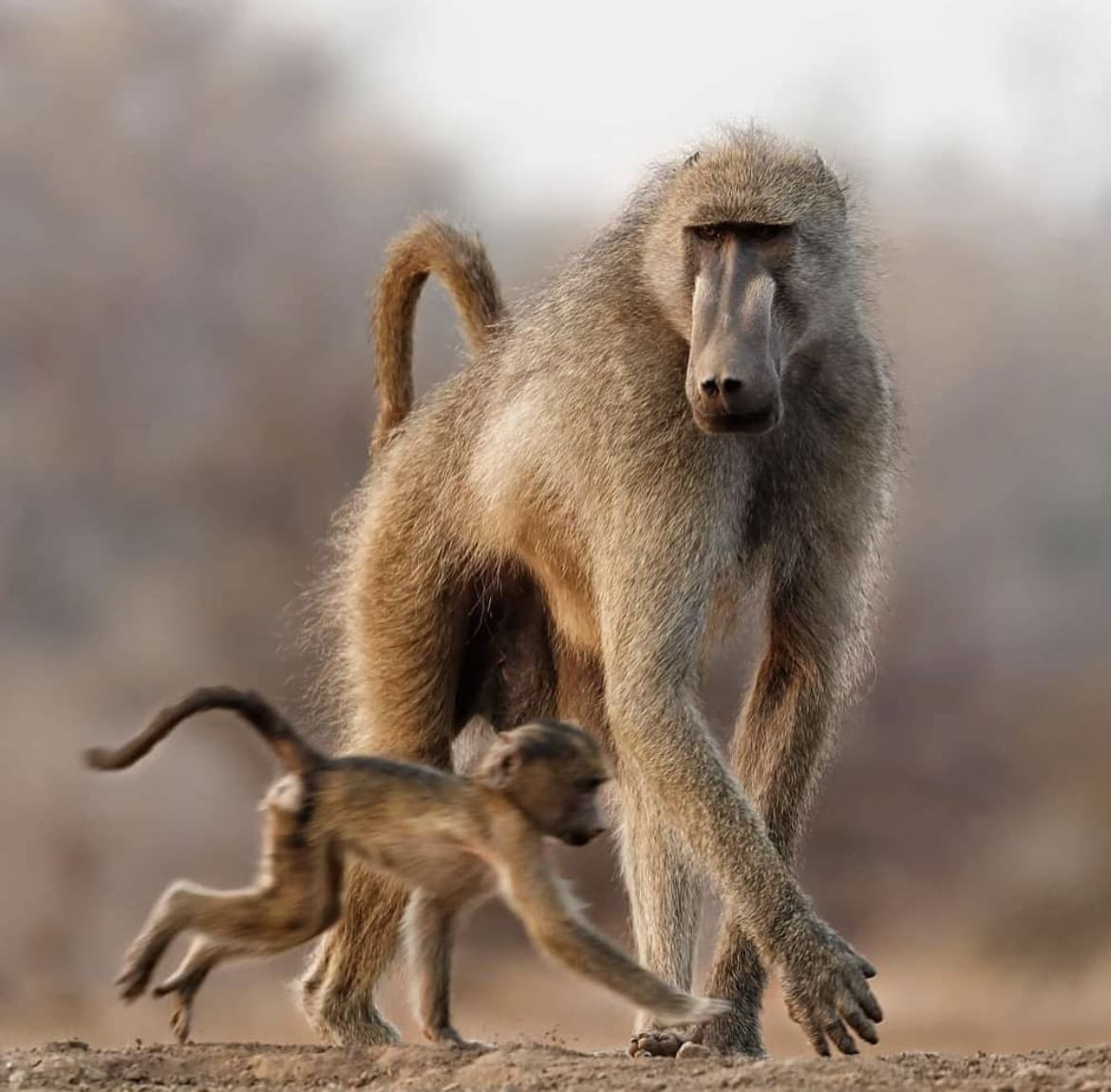
Baboon Species
When we talk about baboons, we’re not just talking about one size fits all. These creatures come in different flavors – five species, to be exact. But it’s the Chacma that steals the show in southern Africa.
Compared to its cousins like the Olive, Guinea, Hamadryas, and Yellow Baboons, the Chacma is like the cool uncle. It’s more robust, more rugged, and has a sense of adventure, living life on the edge in some of the continent’s most challenging terrains.
What sets them apart is not just their size or where they hang out; it’s their unique ability to adapt and thrive, making them a fascinating subject for anyone interested in the complexities of wildlife adaptation and survival.
What Do Chacma Baboons Look Like?
Picture this: a hefty, dog-faced primate with a wise gaze, cloaked in a coat of olive-brown to grey fur. The Chacma Baboon is a sight to behold, with its imposing presence and muscular build.
Males are particularly impressive, sporting a mane of sorts that gives them an air of regal authority. But it’s not all about looks; these baboons are built for the tough life they lead. Their powerful limbs allow them to traverse rugged terrain with ease, while their dexterous hands and feet are perfect for foraging and gripping onto cliffs and trees.
And let’s not forget those expressive faces – a window into their complex social world, where every furrow of the brow and twitch of the lip has meaning. In the world of Chacma Baboons, appearance is not just about survival; it’s about communication, identity, and community.
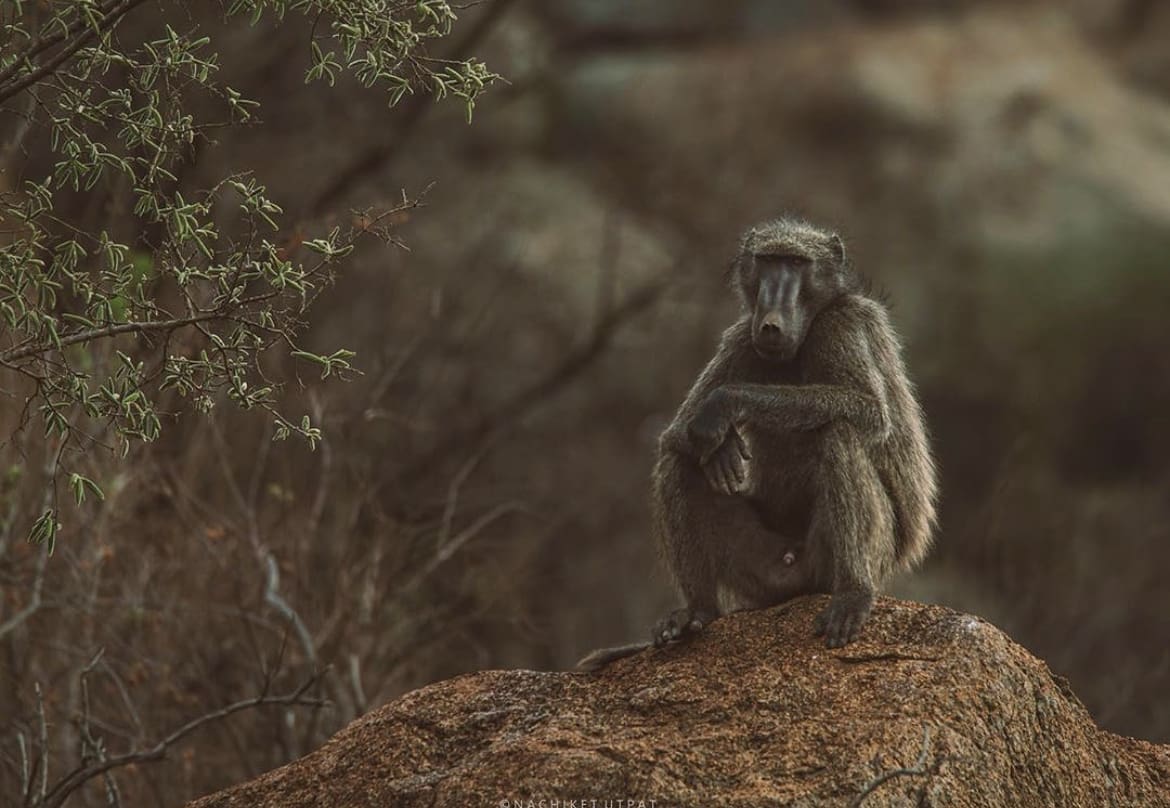
How Big are Chacma Baboons
When it comes to size, Chacma Baboons don’t mess around. These are some of the heftiest monkeys you’ll come across, with males often tipping the scales at a whopping 33 to 45 kilograms (about 73 to 99 pounds).
Ladies, on the other hand, are usually a bit lighter, weighing in at around 15 to 25 kilograms (33 to 55 pounds). But it’s not just their weight that’s impressive; these baboons can stand about 120 cm (47 in) tall, making them quite the imposing figure on the African savannah.
Their size isn’t just for show; it plays a critical role in their survival, from fending off predators to competing for mates. In the world of Chacma Baboons, bigger often means better.
Baboon Teeth
Let’s talk about teeth, baby! Chacma Baboons have a dental arsenal that would make any dentist swoon. Equipped with long, sharp canine teeth, these primates can bite down with a force that’s not just for chewing tough foods.
These canines are a crucial part of their defense mechanism, helping them intimidate rivals and predators alike. But it’s not all about the bite; their molars are perfectly adapted for grinding down a wide range of foods, from fruits to roots.
This dental versatility is key to their omnivorous diet, allowing them to make the most of the diverse buffet that nature offers. In the gritty world of survival, a good set of chompers can make all the difference.
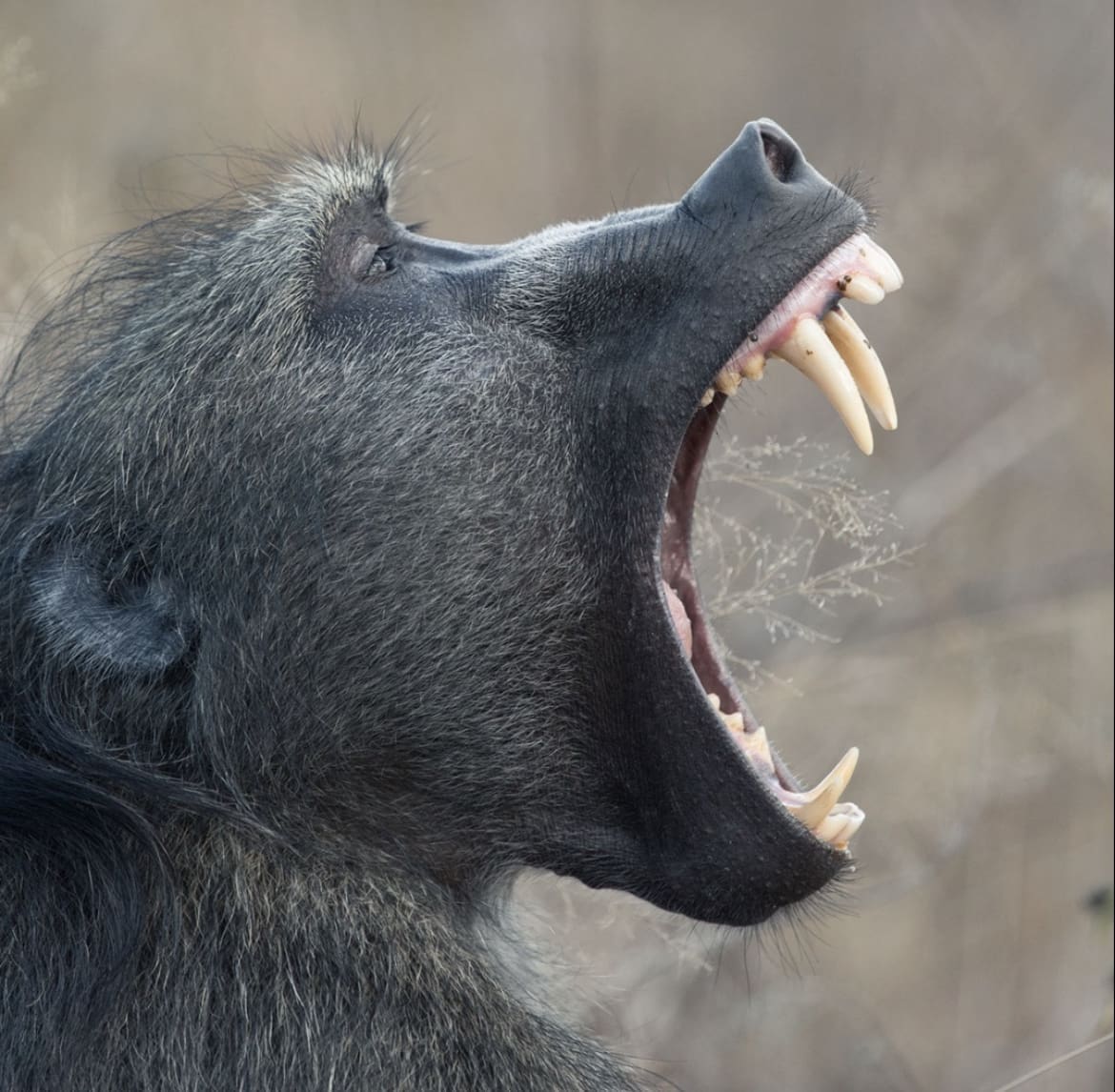
What do Chacma Baboons Eat?
You might be wondering, what’s on the menu for these furry gourmets? Well, Chacma Baboons are not picky eaters. Their diet is as varied as their habitat, encompassing fruits, seeds, grasses, and the occasional insect or small animal.
These omnivores take the term “seasonal eating” to a whole new level, adjusting their diet based on what’s available. During the dry season, they might munch on tubers and roots, while the wet season brings a bounty of fruits and leaves.
This adaptability in their diet reflects their ability to thrive in diverse environments, from the lush Cape Peninsula to the arid Kalahari Desert. For the Chacma Baboon, variety is not just the spice of life; it’s a survival strategy.
Baboon Social Structure
Imagine the most dramatic reality TV show you’ve ever seen – now picture that in the baboon world, and you’ve got a pretty good idea of Chacma Baboon social dynamics. Their social structure is a fascinating web of relationships, hierarchies, and alliances that could rival any human soap opera. Living in troops that can number up to a hundred individuals, life is all about who you know and where you stand. The males have a ranking system that’s all about strength and alliances. The higher you rank, the better your access to food and mates. But it’s not just a brute force game; social grooming plays a crucial role in forming and maintaining these relationships.
Females, on the other hand, inherit their status from their mothers, creating tight-knit family lines within the troop. This matriarchal lineage dictates their access to resources and their position within the social order. But what’s truly remarkable is the sense of community and cooperation among troop members, from caring for the young to defending against predators. In the world of Chacma Baboons, it’s all for one and one for all.

Are Chacma Baboons Aggressive?
Now, let’s tackle a common misconception – are Chacma Baboons the bullies of the animal kingdom? Well, it’s complicated. Like any wild animal, Chacma Baboons can be aggressive, especially when threatened or competing for resources.
Males often show aggression during mating season, using their imposing size and sharp canines to assert dominance. However, labeling them as inherently aggressive misses the bigger picture. Their behavior is deeply rooted in their social structure and survival instincts. Aggression is often a last resort, used to protect their troop or territory.
So, while encounters with humans can sometimes lead to aggressive behavior, it’s usually a response to feeling cornered or provoked. Understanding and respecting their space is key to peaceful coexistence.
Are Baboons Territorial?
Yes, Chacma Baboons are quite territorial, but their concept of territory can be fluid. Rather than defending a fixed piece of land, their territorial behavior is more about protecting their troop and resources.
Their home ranges can overlap with those of other troops, leading to fascinating interactions. Sometimes, it’s a peaceful coexistence; other times, not so much. Males play a crucial role in patrolling and defending their troop’s range, especially during foraging. These territorial disputes can be loud and display-heavy but rarely escalate into serious conflict. It’s all about sending a message: “This is our spot, find your own.”
This territoriality underscores the importance of resources and space in the wild, driving the social and survival strategies of Chacma Baboons.
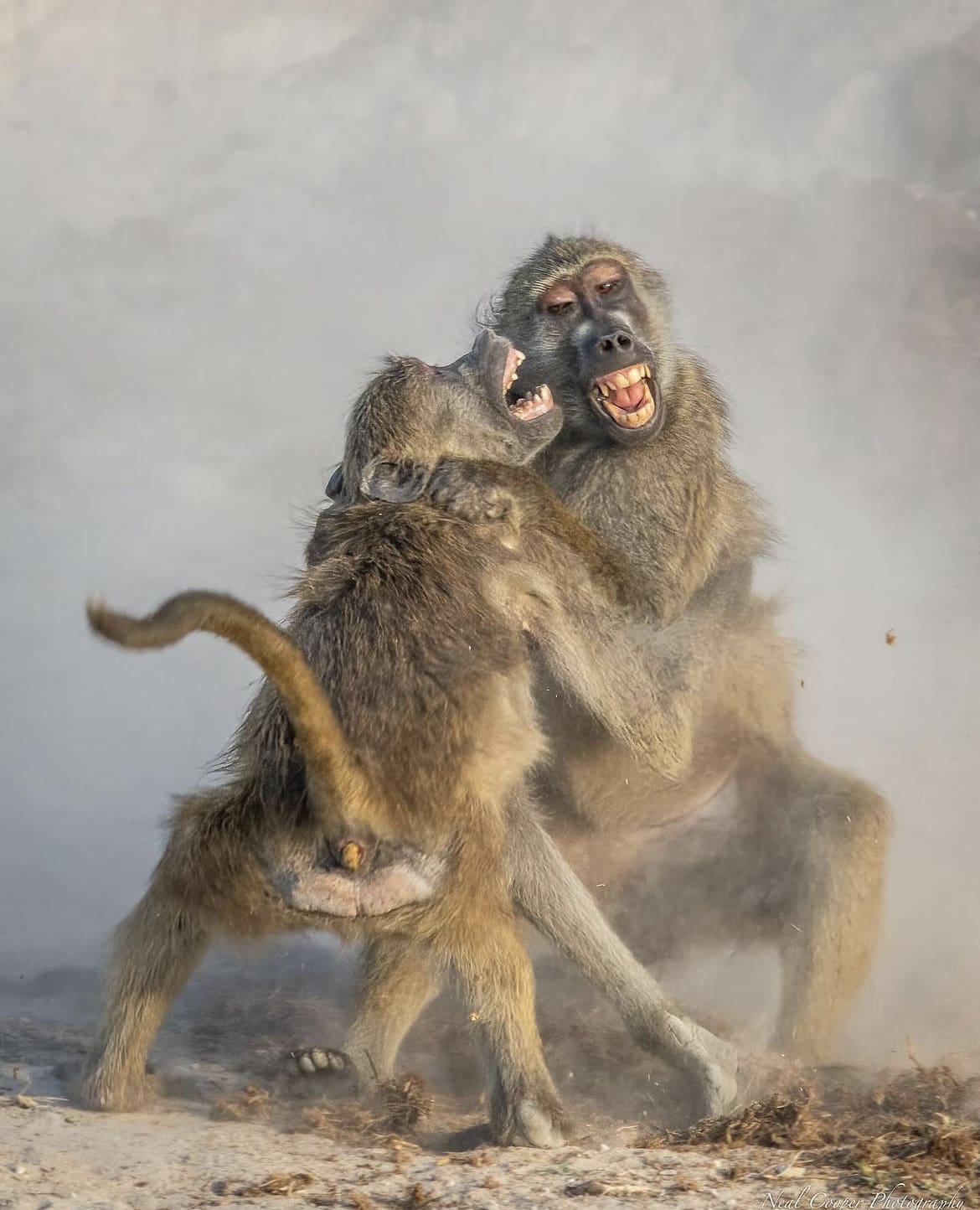
Where do Chacma Baboons Live?
Chacma Baboons are the adventurers of the primate world, thriving in a surprisingly wide range of habitats. From the verdant forests of the Cape Peninsula to the arid expanses of the Namib Desert, these baboons make themselves at home. Their adaptability is nothing short of remarkable, with three distinct subspecies carving out niches in southern Africa. They are found lounging on rocky outcrops in South Africa, navigating the dense foliage of Botswana, and trekking the vast savannahs of Zimbabwe.
Their preference for varied environments underscores their flexibility in diet and behavior, allowing them to exploit different resources based on availability. This adaptability has been key to their survival, enabling them to coexist with human encroachments into their natural habitats. However, it’s this very versatility that often brings them into conflict with humans, as they navigate the fine line between the wild and the urban sprawl.
How Many Chacma Baboons Are There in Africa?
Quantifying the exact number of Chacma Baboons across Africa is a challenging task, owing to their widespread distribution and adaptability to various habitats. However, they are considered to be among the most populous baboon species on the continent. Despite facing threats from habitat loss and human-wildlife conflict, Chacma Baboons have shown resilience, with population estimates remaining relatively stable.
This stability, however, doesn’t paint the full picture of their situation. In some areas, populations are under pressure due to increased urbanization and agricultural expansion, leading to fragmented habitats. Conservation efforts and research are ongoing to better understand their population dynamics and the impact of human activities on their numbers. It’s a delicate balance between preserving these primates’ place in the ecosystem and managing their interactions with human communities.

Are Chacma Baboons Endangered?
Currently, Chacma Baboons are not classified as endangered. They are listed as “Least Concern” by the International Union for Conservation of Nature (IUCN), reflecting their wide distribution and stable population numbers. However, this status should not lead to complacency. They face significant threats from habitat destruction, hunting, and conflict with humans, particularly in areas where their natural habitats overlap with agricultural and urban landscapes.
The “Least Concern” classification masks regional variations in their conservation status, with some local populations experiencing sharp declines. The challenge lies in mitigating human-baboon conflicts and ensuring sustainable coexistence. Conservation measures, including habitat protection, research, and community-based management programs, are crucial in maintaining healthy populations of Chacma Baboons across their range.
Threats to Chacma Baboons in the Wild
Despite their adaptability and general classification as “Least Concern,” Chacma Baboons navigate a minefield of threats in their daily struggle for survival. Habitat destruction stands out as a primary concern, as expanding human settlements, agriculture, and infrastructure development encroach on their natural environments. This loss of habitat not only reduces their living space but also fragments their populations, making it harder for them to find food, mate, and interact with other troops.
Poaching and hunting present another grim reality for these baboons. In some regions, they are hunted for meat, traditional medicine, or in retaliation for crop raiding. Such conflicts arise from the baboons’ increasing interactions with human habitats, where they are drawn to easy food sources like farms and waste bins. Additionally, the pet trade poses a significant threat, with young baboons often captured and sold illegally, disrupting social structures within troops and leading to long-term psychological and physical harm.
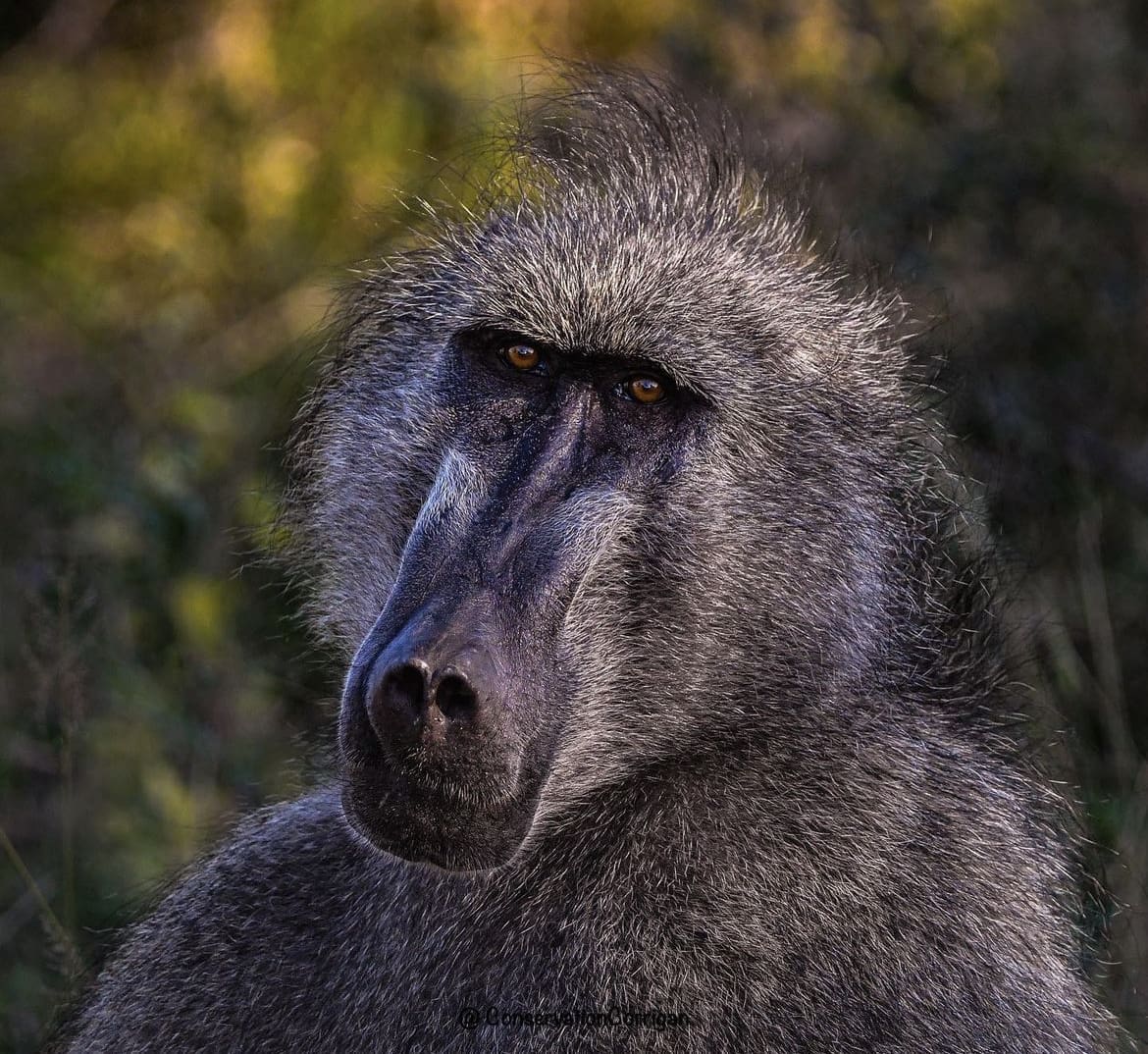
Where to See Chacma Baboons on Safari
For those eager to witness the majesty of Chacma Baboons in their natural setting, Africa offers an array of destinations where these primates can be observed in the wild. The Cape Peninsula in South Africa is renowned for its Chacma Baboon troops, offering visitors a unique glimpse into their lives amidst stunning landscapes. Kruger National Park, also in South Africa, provides another excellent backdrop for baboon watching, with its rich biodiversity and expansive wilderness.
Beyond South Africa, Chobe National Park in Botswana and Hwange National Park in Zimbabwe are fantastic locations to see Chacma Baboons as part of a broader safari experience. These parks not only offer the chance to observe Chacma Baboons but also provide a window into the diverse ecosystems that support a wide range of African wildlife.
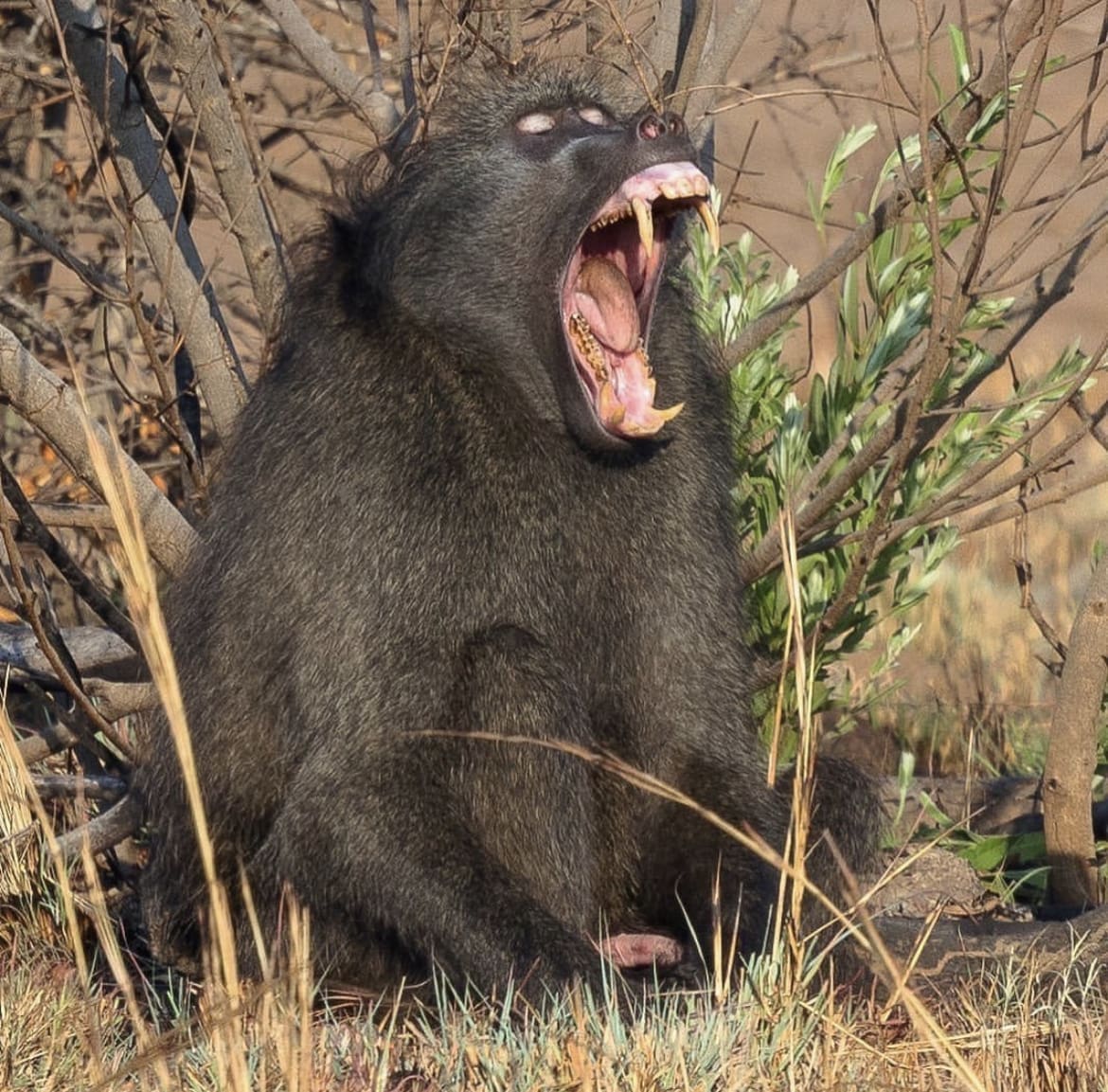
Tips for Spotting Chacma Baboons in the Wild
Spotting Chacma Baboons during a safari can be an exhilarating experience, but it requires patience, respect for wildlife, and a bit of know-how. Here are some tips to enhance your chances of a memorable encounter:
- Early Morning or Late Afternoon: Baboons are most active during the cooler parts of the day, making early mornings and late afternoons the best times for sightings.
- Look for Water Sources: Baboons often visit waterholes and rivers for drinking, especially in arid areas, making these spots ideal for observation.
- Observe from a Distance: Use binoculars or a good zoom lens to watch baboons without disturbing them. Keeping a respectful distance ensures their natural behavior is not altered by human presence.
- Be Patient: Wildlife viewing is a game of patience. Spend time in known baboon territories, and keep your eyes peeled for movement in the trees or on the ground.
- Respect Their Space: Never attempt to feed or interact with baboons. Feeding wildlife can alter their natural behaviors and lead to conflicts.
Facts about Chacma Baboons
- Social Savvy: Chacma Baboons live in complex social structures known as troops, which can consist of up to 100 members. Their social interactions are intricate, involving grooming, vocalizations, and body language to maintain bonds and hierarchies.
- Communication Experts: They communicate using a variety of sounds, facial expressions, and postures, conveying messages ranging from alarm calls to social reconciliation.
- Dietary Flexibility: As omnivores, their diet includes fruits, grasses, seeds, insects, and occasionally small mammals or birds, showcasing their adaptability to different environmental conditions.
- Intelligence: Chacma Baboons are known for their problem-solving abilities and use of tools, such as using sticks to gather honey or stones to crack nuts.
- Longevity: In the wild, Chacma Baboons can live up to 30 years, a testament to their ability to navigate the challenges of their environment.
Myths about Chacma Baboons
- Aggressive by Nature: While Chacma Baboons can display aggression, this behavior is context-specific, often a response to threats or competition. They are not inherently aggressive towards humans or other animals without provocation.
- Pest Status: Often labeled as pests due to their interactions with human habitats, Chacma Baboons’ foraging behavior is a result of habitat loss and the availability of easy food sources, not an innate desire to conflict with humans.
- Limited Intelligence: Contrary to the myth that baboons are not intelligent, Chacma Baboons exhibit complex social behaviors, problem-solving skills, and adaptability, indicating a high level of cognitive function.
- Disease Carriers: While there is a risk of disease transmission between any wildlife and humans, Chacma Baboons are not inherent carriers of diseases dangerous to humans. Proper precautions and distance reduce any potential risk.
The Chacma Baboon, with its nuanced social structures, adaptability, and intelligence, stands as a beacon of the wild’s complexity and resilience. Throughout our journey, we’ve seen how these primates navigate the challenges of their environment, from the threats they face to the beauty of their daily lives. They are not just survivors; they are emblematic of the delicate balance between nature and the encroaching human world.
As we reflect on the world of the Chacma Baboon, it becomes clear that our understanding and actions can significantly impact their survival and well-being. Conservation efforts, responsible tourism, and a deeper appreciation for their role in the ecosystem are crucial in ensuring that Chacma Baboons, and wildlife at large, continue to thrive.
